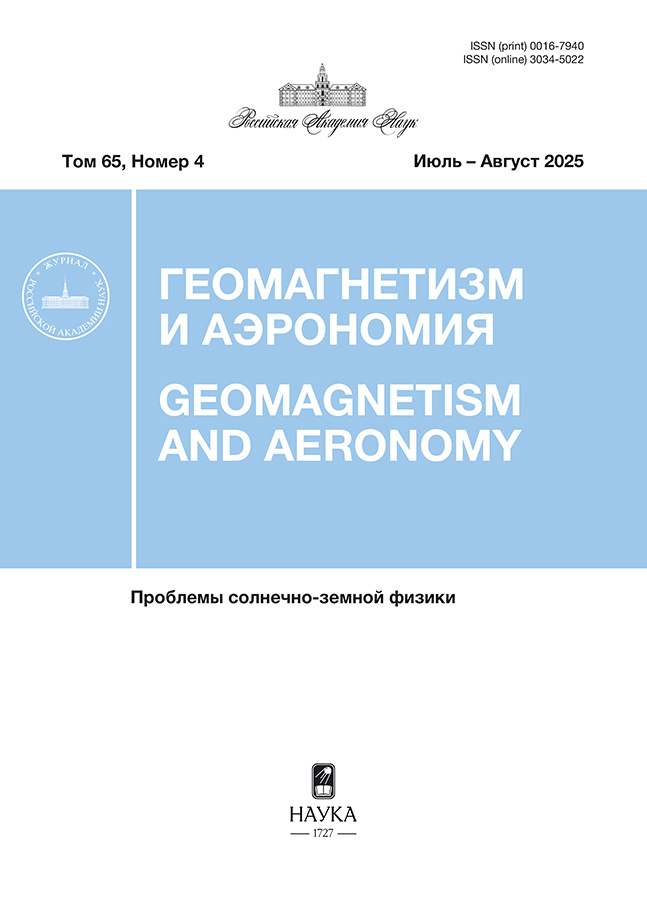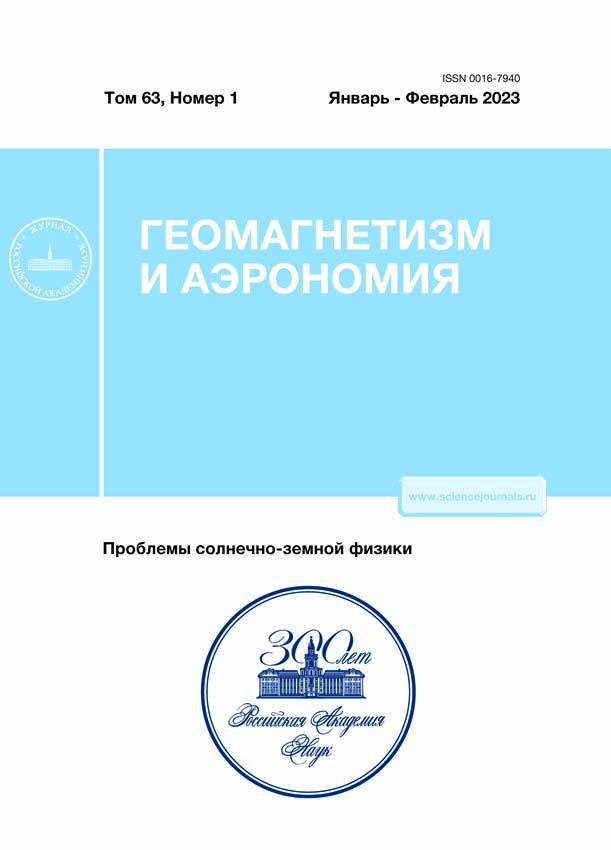The Possible Influence of Cosmic Rays on the Planetary Albedo of the Earth
- Authors: Bogdanov M.B.1, Cherviakov M.Y.1, Koshel A.A.1
-
Affiliations:
- National Research Saratov State University
- Issue: Vol 63, No 1 (2023)
- Pages: 73-79
- Section: Articles
- URL: https://ruspoj.com/0016-7940/article/view/651040
- DOI: https://doi.org/10.31857/S0016794022600570
- EDN: https://elibrary.ru/ADEYAK
- ID: 651040
Cite item
Abstract
The monthly average values of the planetary albedo at the top-of-atmosphere (TOA) and the average
albedo values of the hemispheres were obtained based on the results of measurements for the flux of shortwave
reflected solar radiation, carried out onboard the Meteor-M No. 2 satellite in 2014–2019. The globally
averaged albedo shows an increase over time, as evidenced by the presence of a statistically significant linear
trend. We show that this trend is not associated with a change in the average near-surface temperature of the
planet. It is possible that the increase in albedo is explained by an increase in cloudiness caused by an increase
in the flux of galactic cosmic rays during the decline of the solar activity cycle
About the authors
M. B. Bogdanov
National Research Saratov State University
Email: BogdanovMB@info.sgu.ru
Saratov, 410012 Russia
M. Yu. Cherviakov
National Research Saratov State University
Email: chervyakovmu@mail.ru
Saratov, 410012 Russia
A. A. Koshel
National Research Saratov State University
Author for correspondence.
Email: kafmeteo@mail.ru
Saratov, 410012 Russia
References
- − Авакян С.В., Воронин Н.А. О возможном физическом механизме воздействия солнечной и геомагнитной активности на явления в нижней атмосфере // Исследования Земли из космоса. № 2. С. 28–33. 2006.
- − Богданов М.Б., Червяков М.Ю., Кошель А.А. Десятилетний ряд глобального распределения альбедо по данным ИСЗ “Метеор-М” // Современные проблемы дистанционного зондирования Земли из космоса. Т. 19. № 2. С. 243–251. 2022.
- − Жеребцов Г.А., Коваленко В.А. Влияние солнечной активности на погодно-климатические характеристики тропосферы // Солнечно-земная физика. Вып. 21. С. 98–106. 2012.
- − Кондратьев К.Я., Никольский Г.А. Солнечная активность и климат. 1. Данные наблюдений. Конденсационная и озонная гипотезы // Исследования Земли из космоса. № 5. С. 3–17. 1995.
- – Крымский Г.Ф. Космические лучи и околоземное пространство // Солнечно-земная физика. Вып. 2(115). С. 42–45. 2002.
- – Крымский Г.Ф., Петухов С.И., Павлов Г.С. Моделирование конденсации водяного пара. Четырехточечный потенциал // Оптика атмосферы и океана. 2015. Т. 28. № 12. С. 1059–1064. 2015. https://doi.org/10.15372/AOO20151202
- − Распопов О.М., Веретененко С.В. Солнечная активность и космические лучи: влияние на облачность и процессы в нижней атмосфере (памяти и к 75-летию М.И. Пудовкина) // Геомагнетизм и аэрономия. Т. 49. № 2. С. 147–155. 2009.
- − Скляров Ю.А., Воробьев В.А., Котума А.И., Червяков М.Ю., Фейгин В.М. Измерения компонентов радиационного баланса Земли с ИСЗ “Метеор-М” № 1. Аппаратура ИКОР-М // Современные проблемы дистанционного зондирования Земли из космоса. Т. 9. № 2. С. 173–180. 2012а.
- − Скляров Ю.А., Воробьев В.А., Котума А.И., Червяков М.Ю., Фейгин В.М. Алгоритм обработки данных наблюдений уходящей коротковолновой радиации с ИСЗ “Метеор – М” № 1 // Современные проблемы дистанционного зондирования Земли из космоса. Т. 9. № 3. С. 83–90. 2012б.
- − Almeida J., Schobesberger S., Kürten A. et al. Molecular understanding of sulphuric acid-amine particle nucleation in the atmosphere // Nature. V. 502. Iss. 7471. P. 359–363. 2013.
- − Blunden J., Boyer T., (Eds.) State of the Climate in 2021 // Bull. Amer. Meteor. Soc. V. 103(8). S1–S465. 2022. https://doi.org/10.1175/2022BAMSStateoftheClimate.1
- − Goode P.R., Palle E., Shoumko A., Shoumko S., Montanes–Rodriguez P., Koonin S.E. Earth’s albedo 1998–2017 as measured from earthshine // Geophys. Res. Lett. V. 48. e2021GL094888. 2021. https://doi.org/10.1029/2021GL094888
- − Gray L.J., Beer J., Geller M. et al. Solar influences on climate // Rev. Geophys. V. 48. RG4001. 2010. https://doi.org/10.1029/2009RG000282
- − Karlsson K.-G., Anttila K. Trentmann J. et al. CLARA-A2.1: CM SAF cLoud, Albedo and surface RAdiation dataset from AVHRR data – Edition 2.1. 2020. https://doi.org/10.5676/EUM_SAF_CM/CLARA_AVHRR/ V002_01
- − Laken B.A., Čalogovič J. Composite analysis with Monte Carlo methods: an example with cosmic rays and clouds // Journal of Space Weather and Space Climate. V. 3. A29. 2013. https://doi.org/10.1051/swsc/2013051
- − Loeb N.G., Thorsen T.J., Norris J.R., Wang H., Su W. Changes in Earth’s energy budget during and after the “pause” in global warming: an observational perspective. 2018. https://doi.org/10.3390/cli6030062
- − Marsh N., Svensmark H. Cosmic rays, clouds, and climate // Space Sci. Rev. V. 94. P. 215–230. 2000.
- − Mironova I.A., Aplin K.L., Arnold F., Bazilevskaya G.A., Harrison R.G., Krivolutsky A.A., Nicoll K.A., Rozanov E.V., Turunen E., Usoskin I.G. Energetic particle influence on the Earth’s atmosphere // Space Sci. Rev. V. 194. P. 1–96. 2015. https://doi.org/10.1007/s11214-015-0185-4
- − Morice C.P., Kennedy J.J., Rayner N.A., Winn J.P., Hogan E., Killick R.E., Dunn R.J.H., Osborn T.J., Jones P.D., Simpson I.R. An updated assessment of near-surface temperature change from 1850: the HadCRUT5 dataset // J. Geophys. Res. 2021. https://doi.org/10.1029/2019JD032361
- − Pudovkin M.I., Veretenenko S.V. Variations of the cosmic rays as one of the possible links between the solar activity and the lower atmosphere // Adv. Space Res. V. 17. P. 161–164. 1996.
- − Smith G.L., Priestley K.J., Loeb N.G., Wielicki B.A., Charlock T.P., Minnis P., Doelling D.R., Rutan D.A. Clouds and Earth Radiant Energy System (CERES), a review: Past, present and future // Adv. Space Res. V. 48. P. 254–263. 2011.
- − Stephens G.L., O’Brien D., Webster P.J., Pilewski P., Kato S., Li J.-L. The albedo of Earth // Rev. Geophys. V. 53. P. 141–163. 2015.
Supplementary files














